When Howest University of Applied Sciences adopted Canvas in 2018, they quickly realized their outdated, university-developed survey and evaluation tool could work harder for the Belgian university. With some students attending in-person classes across seven campuses in three cities and others completing courses online, Howest needed to make evaluations and surveys easily accessible within their learning management system.


“We already had digital surveys in place, but Watermark Course Evaluations & Surveys offered more options and possibilities than our previous tool. It’s very user-friendly for the students, there are different ways to communicate with them, and they can take the survey on their mobile phones as well,” said Sanne Tanghe, Quality Assurance at Howest. Today, all 7,500 Howest students complete course evaluations and general surveys through the Watermark Solution.
“We wanted a tool that fit our process so we didn’t have to change too much, but that offered possibilities for surveys and reporting. Watermark allowed us to take course evaluations and general surveys and integrate them into Canvas, while also giving us the option to use a public link. It had everything in one package.”
Sanne Tanghe, Quality Assurance, Howest University of Applied Sciences
Watermark Course Evaluations & Surveys’ pop-ups and reminders drove a 13% increase in Howest’s average response rate for course evaluations, and has significantly improved engagement with distance learning students. “It’s a difficult group to reach because they aren’t on campus a lot,” Tanghe said. “We used to have a response rate of only 25% for general surveys, but [this term’s] survey is still running and we have already reached 63%.”
“Every person responsible for quality within a program can select which questions to ask from a predefined question bank, identify the course they want to evaluate, and when they want to launch the survey,” Tanghe said. Students are not required to complete course evaluations, but some instructors have been able to achieve over 90% response rates through candid communication. “The survey is much more visible thanks to the pop-ups and automatic reminders. Instructors motivate students by explaining why it’s important to the study program, and once they have the results they say, ‘We got feedback from the course evaluation and we will take this action,’” Tanghe said.
“We used to make one survey in Dutch and one in English, and have two different reports [that had to be manually combined]. Now we only have to make one survey, where students can choose their own language. We have all the results in one report, which is very handy,” Tanghe said.
Instructors can immediately access course evaluation results in Canvas, and programs decide how and when to share results with students. The school uses data captured in the tool to adjust course materials, programs, and content, and to guide quality improvement efforts.
“It’s nice that Watermark Course Evaluations & Surveys is always in development, and when we give feedback, an update follows. We are able to email Watermark support and already have a response the next day, which is handy because of the time difference,” Tanghe said.

See how our tools are helping clients right now, get in-depth information on topics that matter, and stay up-to-date on trends in higher ed.